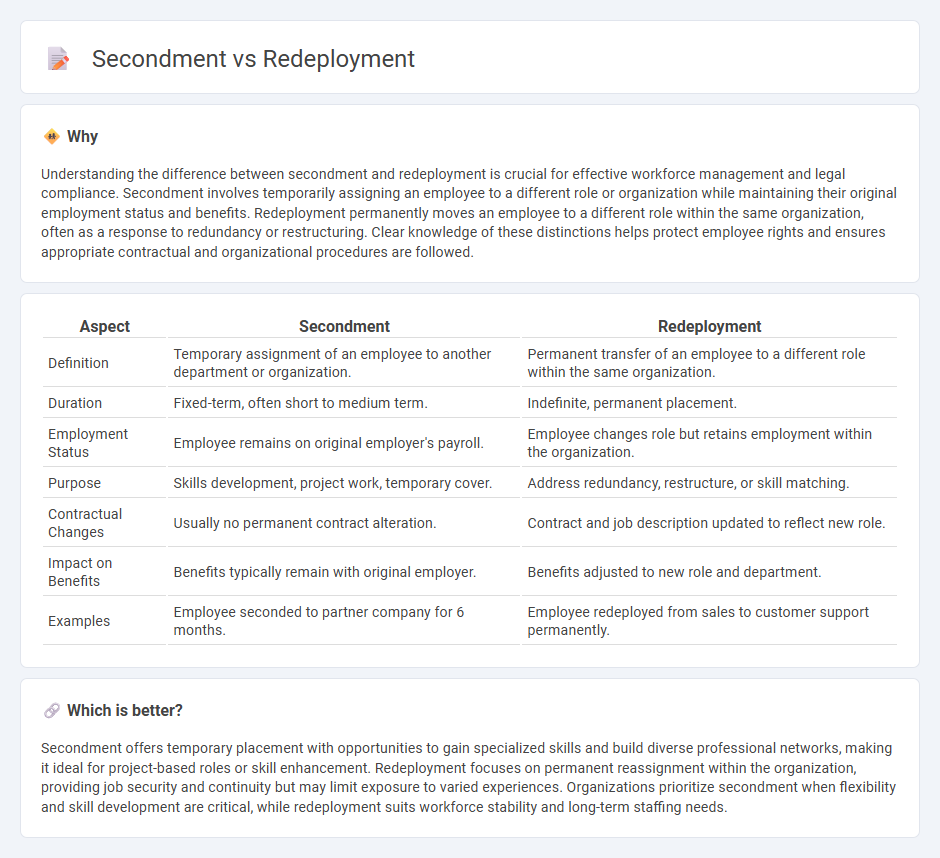
Secondment involves temporarily assigning an employee to a different role or department within the organization, aiming to develop skills and share expertise while maintaining the original employment terms. Redeployment refers to permanently transferring an employee to a new role or location, often due to restructuring or redundancy, with changes in job responsibilities and contract terms. Discover how secondment and redeployment can strategically impact workforce management and career progression.
Why it is important
Understanding the difference between secondment and redeployment is crucial for effective workforce management and legal compliance. Secondment involves temporarily assigning an employee to a different role or organization while maintaining their original employment status and benefits. Redeployment permanently moves an employee to a different role within the same organization, often as a response to redundancy or restructuring. Clear knowledge of these distinctions helps protect employee rights and ensures appropriate contractual and organizational procedures are followed.
Comparison Table
| Aspect | Secondment | Redeployment |
|---|---|---|
| Definition | Temporary assignment of an employee to another department or organization. | Permanent transfer of an employee to a different role within the same organization. |
| Duration | Fixed-term, often short to medium term. | Indefinite, permanent placement. |
| Employment Status | Employee remains on original employer's payroll. | Employee changes role but retains employment within the organization. |
| Purpose | Skills development, project work, temporary cover. | Address redundancy, restructure, or skill matching. |
| Contractual Changes | Usually no permanent contract alteration. | Contract and job description updated to reflect new role. |
| Impact on Benefits | Benefits typically remain with original employer. | Benefits adjusted to new role and department. |
| Examples | Employee seconded to partner company for 6 months. | Employee redeployed from sales to customer support permanently. |
Which is better?
Secondment offers temporary placement with opportunities to gain specialized skills and build diverse professional networks, making it ideal for project-based roles or skill enhancement. Redeployment focuses on permanent reassignment within the organization, providing job security and continuity but may limit exposure to varied experiences. Organizations prioritize secondment when flexibility and skill development are critical, while redeployment suits workforce stability and long-term staffing needs.
Connection
Secondment and redeployment both facilitate workforce flexibility by temporarily or permanently assigning employees to different roles or departments. Secondment involves a fixed-term transfer, often for skill development or project needs, while redeployment addresses longer-term organizational adjustments, such as restructuring or redundancy avoidance. Both strategies optimize talent allocation and maintain employee engagement during periods of change.
Key Terms
Temporary Assignment
Temporary assignments often distinguish redeployment and secondment through duration and purpose, where redeployment involves permanent role changes within the same organization and secondment denotes a fixed-term placement, sometimes with a separate entity. Both strategies aim to utilize workforce flexibility and develop employee skills while managing resource allocation efficiently. Explore more insights on optimizing temporary assignments to enhance organizational agility and talent development.
Role Change
Redeployment involves permanently moving an employee to a new role within the organization, often due to restructuring or redundancy, ensuring long-term job security and skill utilization. Secondment refers to temporarily transferring an employee to another role or department, aiming to develop skills and experience without terminating the original employment contract. Explore the key distinctions and benefits of role changes through redeployment or secondment to enhance workforce flexibility and career growth.
Employee Mobility
Employee mobility involves strategic workforce management where redeployment shifts employees within the same organization to different roles or locations, enhancing internal talent utilization and retention. Secondment temporarily places employees in external organizations or different departments to gain specialized experience and foster cross-organizational collaboration. Explore further to understand how redeployment and secondment can optimize your company's talent mobility strategy.
Source and External Links
Redeployment: A Guide for HR Managers & Employers - Personio - Redeployment is when an employer moves an employee from one role to another, often to avoid redundancies, typically involving a process of offering alternative roles, a trial period, and confirmation of the new position.
What Is Redeployment? - Staffing Network - Redeployment is an internal transfer of employees to fill vacancies while saving recruitment costs and can improve adaptability, staff morale, and company culture during organizational restructuring.
Redeployment: Home - REDEPLOYMENT is also the name of a recruiting firm specializing in placing veterans into civilian roles within biotech and defense industries.
 dowidth.com
dowidth.com